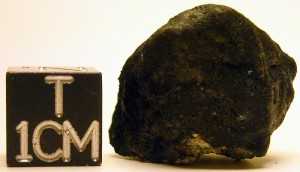Ash Creek Expedition: 6.7g Meteorite Find!

Hunting meteorites is rarely an easy task. Here is a diary of Eric Wichman’s trials and tribulations over the course of Feb. 21 to 24, 2009 hunting the Ash Creek meteoriteWork in progress. A solid natural object reaching a planet’s surface from interplanetary space. Solid portion of a meteoroid that survives its fall to Earth, or some other body. Meteorites are classified as stony meteorites, iron meteorites, and stony-iron meteorites. These groups are further divided according to their mineralogy and Click on Term to Read More fallMeteorite seen to fall. Such meteorites are usually collected soon after falling and are not affected by terrestrial weathering (Weathering = 0). Beginning in 2014 (date needs confirmation), the NomComm adopted the use of the terms "probable fall" and "confirmed fall" to provide better insight into the meteorite's history. If Click on Term to Read More in the area around the city of Ash Creek, TX.
In a small town North of Waco, Texas, scientists from the University of North Texas and some lucky meteorite meteorite hunters found meteorites from the Feb. 15 fireballA fireball is another term for a very bright meteor, generally brighter than magnitude -4, which is about the same magnitude of the planet Venus as seen in the morning or evening sky. A bolide is a special type of fireball which explodes in a bright terminal flash at its end, often with visible fragmentation. Click on Term to Read More in the sky. There was a giant explosion that sent one local farmer scrambling for cover under his barn after he witnessed the explosion and the break up of the meteorHow long Sonic booms Of the several 10s of tons of cosmic material entering Earth's atmosphere each day, only about one ton reaches the surface. An object's chance of survival depends on its initial mass, speed and angle of entry, and friability (tendency to break up). Micrometeoroids radiate heat so Click on Term to Read More. Seconds later it started raining stones down on his fields and he had to run to his barn to escape the extraterrestrial bombardment. He reported that he could hear the stones pelting the ground and roof of his barn where he was taking shelter (as reported by Michael Farmer to the Met-List, note: I’m trying to findMeteorite not seen to fall, but recovered at some later date. For example, many finds from Antarctica fell 10,000 to 700,000 years ago. Click on Term to Read More this reference with no luck).
Here is Eric’s story, in his own words:
Feb 21: Day 0 and sick with a cold after planning the trip and raising funds for expedition. Trip postponed for 24 hrs.
Feb 22:Day 1, 10:00 am and started out for Texas. Driving non-stop from San Diego, CA. Google maps said 19hrs 48mins. They lied! lol ;-)
Feb 23: Day 2, after driving 1200 miles straight without rest, we stopped at 5:30 am local time in a rest area just outside Abilene, TX and napped for about 3 hours. We woke up about 9:00 am and continued on toward West, TX . We arrived in West at about 1:30 pm local time. We did some quick preliminary searching in a predefined search area and then check in to our cabin at the local KOA campground. We could have stayed in a hotel in Waco but liked the idea of being closer to the strewnfield.
Around 3 pm we arrived at the spot where the first meteorite was located. We, of course, searched the area again hoping something might have been missed … lol – Fat chance. Professional hunters had been through here and had no less than 7 days to search this area thoroughly.
We met up with Ruben Garcia and Mike Miller and after showing us their new finds and and speaking with a local landowner they were off. We hunted a local field with permission from the landowner until dark with no finds and called it a day.
Feb 24th: Day 3 and up early 5am … Hunting …
Feb 25th: Day 4 and my first meteorite found! After much researching, searching, collaborating, driving, and some luck, ten days after a meteorite fell to Earth in West, Texas, I found my first piece of Ash Creek! It’s a nice little fragment of this beautiful chondriteChondrites are the most common meteorites accounting for ~84% of falls. Chondrites are comprised mostly of Fe- and Mg-bearing silicate minerals (found in both chondrules and fine grained matrix), reduced Fe/Ni metal (found in various states like large blebs, small grains and/or even chondrule rims), and various refractory inclusions (such Click on Term to Read More. Gorgeously fresh fusion crustMelted exterior of a meteorite that forms when it passes through Earth’s atmosphere. Friction with the air will raise a meteorite’s surface temperature upwards of 4800 K (8180 °F) and will melt (ablate) the surface minerals and flow backwards over the surface as shown in the Lafayette meteorite photograph below. Click on Term to Read More and a spectacular whitish gray matrixFine grained primary and silicate-rich material in chondrites that surrounds chondrules, refractory inclusions (like CAIs), breccia clasts and other constituents. Click on Term to Read More.
Here are a few additional photos:










